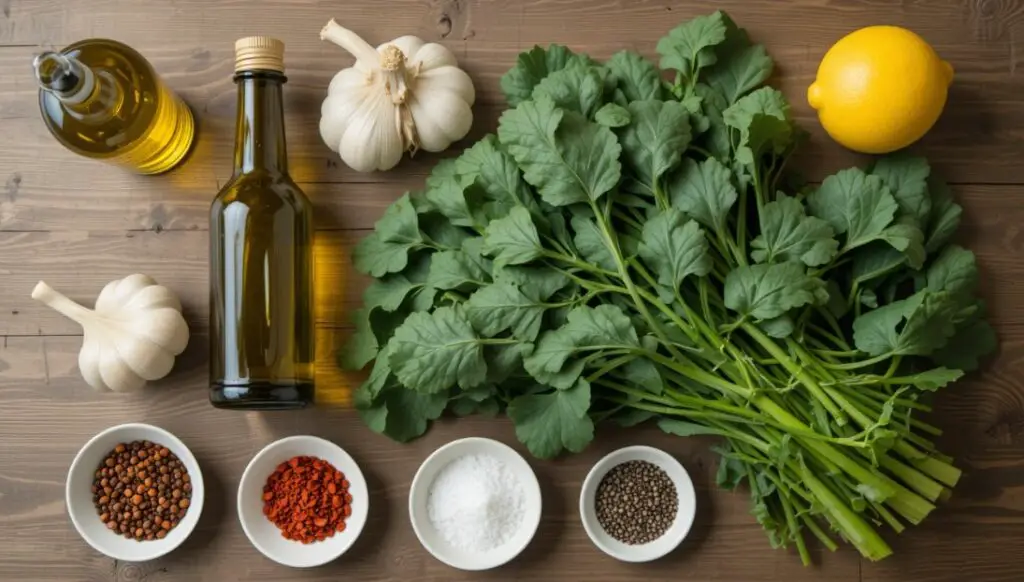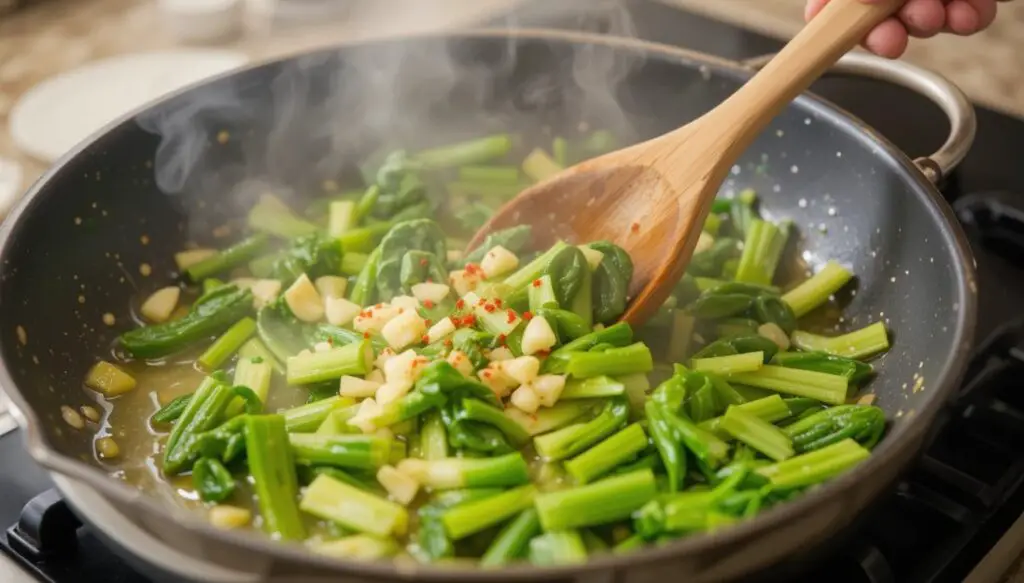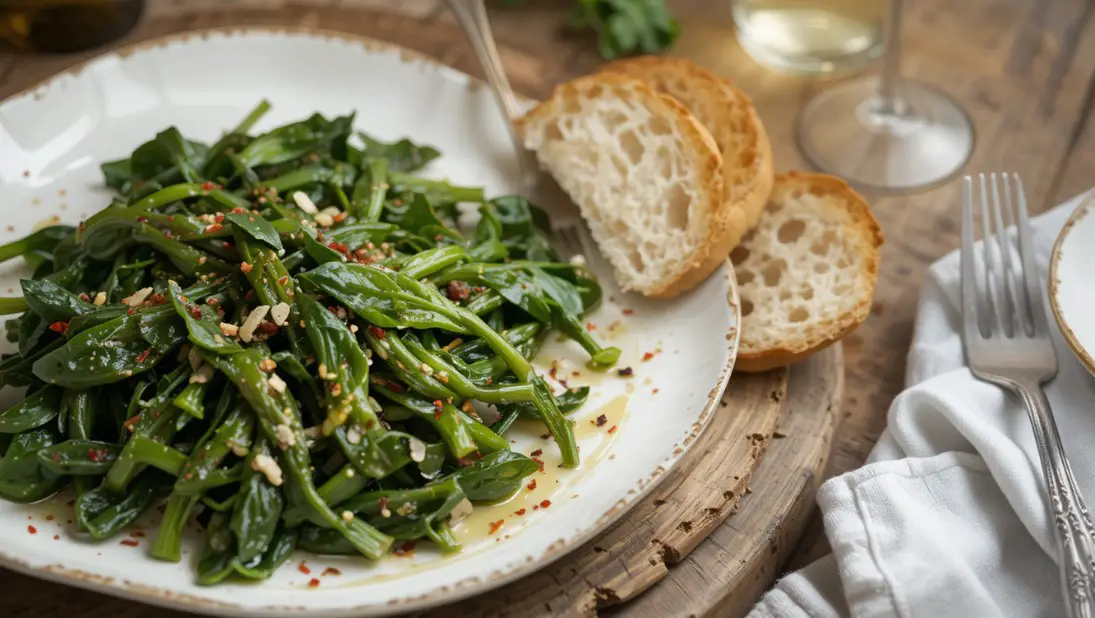Rapini is a leafy green vegetable that resembles broccoli but belongs to the turnip family. It is widely used in Italian, Chinese, and Portuguese cuisines. The entire plant, including its leaves, stems, and small florets, is edible and packed with vitamins A, C, and K, as well as iron, calcium, and potassium.
When selecting rapini for cooking, choose bunches with dark green leaves and tightly closed florets. Avoid yellowing leaves or flowers, as they indicate an older and more bitter plant. The key to cooking rapini successfully is balancing its natural bitterness with flavorful ingredients.
Health Benefits of Rapini: A Nutrient Powerhouse in Your Kitchen
Rapini broccoli recipes are not just about great taste; they also offer numerous health benefits. Here’s why you should add this vegetable to your diet:
- Rich in Antioxidants – Rapini contains antioxidants that help fight inflammation and support overall health.
- High in Fiber – A diet rich in fiber aids digestion and promotes gut health.
- Packed with Vitamins – It is an excellent source of vitamins A, C, and K, which boost immunity and bone health.
- Supports Heart Health – The potassium and fiber in rapini help maintain healthy blood pressure levels.
- Low in Calories – Perfect for weight-conscious individuals looking for a nutrient-dense addition to their meals.
Including rapini in your meals ensures you get a powerhouse of nutrients while enjoying unique and delicious rapini broccoli recipes.
How to Reduce the Bitterness of Rapini: Expert Tips and Tricks
Many people shy away from rapini due to its natural bitterness. However, following these expert tips will help mellow its flavor:
- Blanch Before Cooking – Boiling rapini for 2–3 minutes before sautéing reduces its bitterness significantly.
- Use Acidic Ingredients – A squeeze of lemon juice or a splash of vinegar can help balance the bitterness.
- Sauté with Garlic and Olive Oil – The richness of olive oil and the sweetness of garlic enhance rapini’s flavor.
- Pair with Cheese – Grated Parmesan or Pecorino Romano adds a savory contrast to the bitterness.
- Choose Fresh Rapini – Younger, fresher rapini has a milder taste compared to older, flowering stalks.
Now that you know how to make rapini taste delicious, let’s dive into some step-by-step rapini broccoli recipes.
Classic Rapini with Garlic and Olive Oil: A Flavorful Italian Recipe
This is the most traditional way to enjoy rapini. It’s simple, delicious, and packed with flavor.
Ingredients:
- 1 bunch rapini (about 15 ounces)
- 3 large garlic cloves, crushed
- 3 tablespoons extra-virgin olive oil
- 1/4 teaspoon red pepper flakes (optional)
- 1/4 teaspoon sea salt
- 1/4 teaspoon ground black pepper
- 1 tablespoon lemon juice (optional)

Step-by-Step Instructions:
- Boil Water – Fill a large pot with water and bring it to a rolling boil.
- Blanch Rapini – Add rapini to the boiling water and cook for 2–3 minutes, then drain and rinse under cold water.
- Sauté Garlic – In a large pan, heat olive oil over medium heat and add crushed garlic. Sauté until golden brown.
- Add Rapini – Toss the drained rapini into the pan and stir well to coat with oil and garlic.
- Season – Sprinkle with red pepper flakes, salt, and black pepper. Cook for another 3–5 minutes.
- Finish with Lemon Juice – For extra flavor, drizzle with lemon juice before serving.
This classic dish is perfect as a side to grilled meats, pasta, or even on its own with crusty bread.
Delicious Rapini Broccoli Recipes for Every Palate
Here are more unique ways to cook rapini:
1. Rapini and Sausage Pasta
Combine blanched rapini with Italian sausage, garlic, and olive oil. Toss with cooked pasta and top with Parmesan cheese.
2. Rapini Stir-Fry
Stir-fry rapini with soy sauce, ginger, and tofu for an Asian-inspired dish.
3. Rapini and Eggs
Sauté rapini with garlic, then mix with scrambled eggs or add to an omelet.
4. Rapini Pizza
Top pizza dough with blanched rapini, mozzarella, and spicy sausage for a gourmet twist.

Pairing Rapini with Proteins: Best Meat and Vegetarian Combos
Rapini pairs well with many proteins. Here are some great pairings:
- Meat – Italian sausage, grilled chicken, and beef complement the bold flavors of rapini.
- Seafood – Shrimp, salmon, and anchovies add a delicious umami flavor.
- Vegetarian Options – Pair rapini with beans, tofu, or chickpeas for a hearty plant-based meal.
Storing and Reheating Rapini: Keep It Fresh and Flavorful
To enjoy rapini broccoli recipes at their best, follow these storage and reheating tips:
Storing:
- Keep fresh rapini in the refrigerator, wrapped in a damp paper towel, for up to 5 days.
- Store cooked rapini in an airtight container in the fridge for up to 3 days.
Reheating:
- Reheat in a pan over medium heat with a little olive oil.
- Microwave on a low-power setting for 1–2 minutes.
- Avoid overheating, as this can make rapini mushy.
FAQs About Rapini: Everything You Need to Know
1. Why is rapini so bitter?
Rapini naturally contains bitter compounds, but blanching and pairing it with flavorful ingredients can help reduce its intensity.
2. Can you eat rapini raw?
While rapini can be eaten raw, it’s best enjoyed cooked to mellow its bitterness.
3. What is the difference between rapini, broccoli rabe, and broccolini?
Rapini and broccoli rabe are the same vegetable, while broccolini is a hybrid of broccoli and Chinese broccoli, with a sweeter taste.
Conclusion
Rapini broccoli recipes offer a delicious and nutritious way to enjoy this bold vegetable. Whether you prefer it sautéed with garlic and olive oil, paired with pasta, or added to a hearty protein dish, there are countless ways to prepare rapini to suit your taste. With the right techniques, you can transform this bitter green into a flavorful favorite in your kitchen. Try out these recipes and enjoy the incredible flavors of rapini today!



